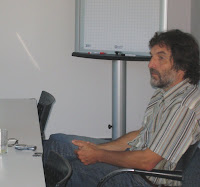In the resent month the question about ubiquitous, pervasive, ambient computing came up several times. An email by Jos Van Esbroeck motivated me to write my view on it…
Clarifying the terms seems an ongoing process as various communities and individuals use each of those terms for new things they are doing.
For me the best way to discriminate the terms ubiquitous computing, pervasive computing, and ambient intelligence is by their origin, history and research communities.
The first term (ubiquitous computing, ubicomp) is linked to Mark Weiser and his vision of computing in the 21st century [1]. In the research community its is very much connected to ubiquitous and pervasive systems that have the user somewhere in the loop. The ubicomp conference [2] seems more focused on user experience than on pure technology.
Pervasive Computing was pushed in the mid 1990s, more by industry and in particular by IBM. Pervasive computing seems from its origin more focused on technologies and solutions than on a particular vision. The two major conferences related to this topic: pervasive [3] and percom [4] are more systems and network focused, however always keeping some attention to the user experience perspective. Here, in particular with percom, many in the research community have their origin in the networking and distributed systems world. To me pervasive computing seems more technical than ubiquitous computing and includes systems that do no have direct human users involved.
The term ambient intelligence was introduced by the European funding agencies in the Framework 5 vision. Around the same time as the Philips Home-lab that drives the term, too. Here, similar to ubicomp, the vision of a new quality of user experience is a driving factor. The research that falls under this label by now is broad and I think it is very similar to the research in ubiquious computing. There is also a European conference on ambient intelligence [5].
Many people that are involved in ubicomp/pervasive/percom are also active in one more traditional research community. In particular many people are additionally involved in user interface research (e.g. CHI-Community), mobile computing and mobile systems, networking and distributed systems.
A very early topic related to the whole field is context-awareness as introduced by Schilit [6] who was working with Weiser. In my PhD dissertation I have looked more into the relationship between ubicomp and context-awareness – it has the title Ubiquitous Computing – Computing in Context [7]
In parallel subtopic in the above field have emerged that look at specific aspects, e.g. internet of things [8] (not necessarily a human in the loop), wearable computing (computing in cloth), smart environments (computing in buildings and furniture), tangible and embedded interaction [9] (looking at the interaction side), smart objects, … and probably many more.
There is also an interesting trend that many of the topics, if they are a bit matured, move back into the traditional communities.
[1] Mark Weiser. The Computer for the Twenty-First Century. Scientific American 265, 3 (September 1991), 94-104
[2] http://www.ubicomp.org/
[3] http://pervasive2008.org/
[4] http://www.percom.org/
[5] http://www.ami-07.org/
[6] B. Schilit, N. Adams, and R. Want. (1994). „Context-aware computing applications„. IEEE Workshop on Mobile Computing Systems and Applications (WMCSA’94), Santa Cruz, CA, US: 89-101 .
[7] Albrecht Schmidt(2003). „Ubiquitous Computing – Computing in Context„. PhD dissertation, Lancaster Univeristy.
[8] http://www.internet–of–things-2008.org
[9] http://www.tei-conf.org/
Some findings in short, people talked about/made descions: going on holiday (63%), buying a car (50%), moving (40%), getting a pet (26%), getting married (23%). The main reason for the car on a long journey being an effective environment for communication seems the fact the people are close together for a long time and no-one can walk away (41%). Also the fact that you have reason not to look the other person into the eyes, as you have to watch the street, was valued.

